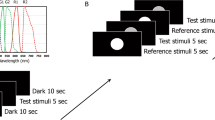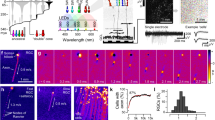Abstract
SINCE the time of Purkinje and Ritter, it has been known and often confirmed that a galvanic current passed through the eye elicits a sensation of bluishviolet when the electrode on the bulb is an anode, of greenish-yellow when it is a cathode. Kravkov and Galochkina1 have recently shown that the anodal pole (on the eye) enhances the sensitivity to short wavelengths and depresses that to long wavelengths, whereas the cathodal pole has opposite effects. In view of the results on different polarity in retinal elements isolated by the micro-electrode technique, reported above2, it was thought to be of interest to combine polarization of the retina with measurements of the colour sensitivity of such elements. The micro-electrode technique and the cat's eye were used, as above2. The strength of the current was 1.0 mA.
This is a preview of subscription content, access via your institution
Access options
Subscribe to this journal
Receive 51 print issues and online access
$199.00 per year
only $3.90 per issue
Buy this article
- Purchase on Springer Link
- Instant access to full article PDF
Prices may be subject to local taxes which are calculated during checkout
Similar content being viewed by others
References
Kravkov and Galochkina, C.R. Acad. Sci. U.S.S.R., 48, No. 1 (1945).
Gernandt and Granit, see preceding communication.
Granit and Tansley, in the press.
Granit, "Sensory Mechanisms of the Retina" (Oxford Univ. Press, 1947).
Author information
Authors and Affiliations
Rights and permissions
About this article
Cite this article
GERNANDT, B. Colour Sensitivity, Contrast and Polarity of the Retinal Elements. Nature 159, 806–807 (1947). https://doi.org/10.1038/159806b0
Issue Date:
DOI: https://doi.org/10.1038/159806b0
Comments
By submitting a comment you agree to abide by our Terms and Community Guidelines. If you find something abusive or that does not comply with our terms or guidelines please flag it as inappropriate.



